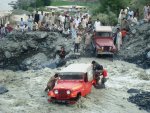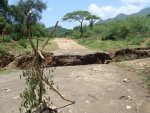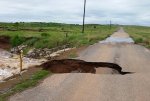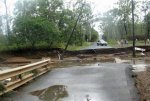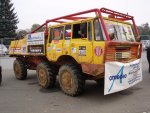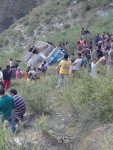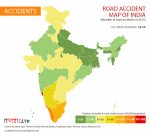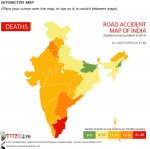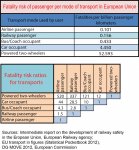I think one detail missed on the "chinese six" configuration when used on a 6x6 vehicle is that with the dual steering axles an inter-axle differential is necessary - while with the traditional single steering axle the back two axles do not include an inter-axle differential. This reduces the cost and complexity involved.
Most of the older trucks where not 6x6 but just had the single rear drive axle powered. Adding a second front steering axle was an inexpensive way to increase the payload capacity since it is not a powered axles. Since each of the four front wheels is allowed to rotate as required, tire scrubbing is minimized compared to having a tandem rear drive axle setup which will scrub tires since only cross axle differentials are included.
If the vehicle is designed for low traction surfaces only (like a truck trials rig or a snow rig) then the benefit of the dual steering axles would be substantial and a inter-axle differential is not needed (or even perhaps desirable).
I think that Tatra's include interaxle differentials between the two forward and the two rear axles - not sure what is done on a MAN type truck - anyone know if they are different?
.....well, most of that won't be a "problem" - IF the terraliner uses separate e-motors for each wheel or even only every seperate axle....
thjakits

PS:
Bio, NO I don't have Chinese-6 experience, but I DO have a little tandem-rear drive experience (2 drive axles, fully lockable, Heavy Load transport).
Under the right "wrong" conditions, it can push you right of the road! Under normal conditions (perfect traction) it WILL torture ALL your tires, mostly the front ones, but a RIGID rear tandem will twist itself into a tire shredding, power-eating nightmare. Imagine 20 tons on a dual-drive-tandem with 8 wheels. axle to axle a bit over a meter at full steering lock (front axle) - NO rear steering (active or passive) - basically EACH tire is working against each other tire.
You need a LOT more power once you get into that kind of situation, just to burn it up sliding rubber across the tarmac!!
NO need for specific Chinese-6 experience - common sense and design analysis will do just fine to realize that 2 front steering axles is a LOT better than anything else.
I don't think the KAMAZ Typhoon is a one purpose only vehicle. Russians do not tend to make single purpose stuff for the military.
There is already TWO versions of the Typhoon and I bet sooner or later you will see a 4-axle transport version!
That you don't see that many Chinese-6 anymore in general transport is PURE economy (penny pinching....)
[The Austrian Crane tractors are special purpose builds, most likely because a tandem rear drive rig would be too long for the purpose - (to get the Crane further back and axle loads into check) - so the sensible thing is getting another axle up front, which gives them 20 tons technically and 16 tons legally on that end ... or too short for a regular rear tandem to support a cargo platform and still get the front axle weight into legal limits....]
Even on the common long distance over-the-road trucks, it would not matter if you had 2 rear axles or 2 front steerers. There it is more a road-legal matter.
Max axle numbers allowed, Max axle weights allowed, Max STEERING axle weights vs. DRIVE/LOAD axle weights allowed, etc...
Compare the TYPICAL US/OZ tractor trailer configuration vs. the TYPICAL EU-configuration. Tractor power levels, cargo weights and GVW are pretty much in the same ball-park. Configurations are totally different (US/OZ: 3-axle tractor, tandem dual-rear drive, trailer with 2/3 axles at the end of the trailer, still mostly with dual wheels; EU: 2-axle tractor, 3axle trailer - with the trailer axles moved way under the cargo, single wheels)
What do I get at? I think your weight-distribution theory is not entirely accurate. Look at the Typhoons (Kamaz and Ural) Kamaz has the tandem rear quite a bit more forward to support the same weight. Kamaz puts the axles at the outer ends of the load-area and the front axles carry most of the power unit on both....
I think LOAD distribution is NOT a primary factor for a decision pro/con Chinese-6. Especially for Terraliner, as you still can move things around at will.
If you must use a rear tandem configuration, at least do yourself a favor and use one steering axle there to at least eliminate "pushing" .....
[I don't think that the commonly referred to Mercedes Luxury RV rear tandem has a steered rear axle.....]
On any "Truck turned RV", load distribution tends to be rather low priority (over functionality), as the resulting RV mostly ends up being WAY lighter than the original truck - to the tune to be able to convert to single wheel and having to slim the springing [ ...maybe except for the light delivery truck turned expedition rig]
Mostly you DO NOT want to be at the axle load limits for a rig like the Terraliner - mainly because you want some reserve for the situations, where you have most off the total load on ONE axle and nearly NOTHING on the others....NOT a common situation on most over-the-road tractors......[more so on Expo Rigs]
What was your projected GVW? 14-16 tons?? WHY would you actually need 3 axles?? (with 8-ton and 10-ton limits on axles you really only NEED 2 and even have some spare...., what you really WANT though is 3 axles!)
See - LOAD considerations are not the real matter here - OFF-road-ability IS!
One design-point you might want to aim for is: MAX OFF-road-ability! NOT to actually do off-road, but to have the extra-abilities to avoid BAD ROAD-hassles when you encounter them!
"Better be able to just switch in AWD and just power through the "hassle", than having to rig a cable, unload everything and hopefully wiggle your way through with you ROAD truck...."
As you demonstrated in your list of "Most dangerous roads" - the actual road conditions mostly do not need even AWD or lots of articulation or even OFF-road tires. Most of the dangers arise from sides that you have not much of a way to DESIGN for and around:
Weather, lack of rails and/or road maintenance, lack of common sense and stupid people!
[Well, the Strada delle 52 gallerie is just a little tight for a Terraliner, but the actual road condition is fine! If you are nuts enough, take a Subaru on Street tires and go for it.....]
Generally it is more like flooded roads, river crossings, landslides on roads you will need to deal with.
Generally you will scout if your rig FITS a track for size or not....
[Just so happened I was a passenger on one of those "Most Dangerous Roads" last Tuesday - Quillabamba to Cusco in Peru - no joke, it is dangerous!
Our "Expo"-Vehicle? A stock Toyota Yaris!! (My relieve searched for this specific one for over an hour! This one had 4 decent tires! Most others have 1/2 decent ones on the front and junk at the rear!)
The road? 2-lane blacktop (for most of the distance in excellent condition)!
Dangers?
- Mostly NO safety rails - go over the edge and nearly free-fall to the road below or until you hit the river below....you'll have time to finish your prayer...
- Stupid people overtaking in blind turns!
- Stupid people NOT waiting for the trucks of a convoy to pass, even though they have a forward and trailing guide car warning and advising...
(Curves are way to tight for a 60 ton rig to stay on their lane only)
- Tourists on bicycles doing downhill and getting scared and out of control! .....actually these are arranged tours, with mini-buses trucking people up to the top with a trailer full of bikes in tow - .....one of them did the "passing a truck in a blind spot" stunt!!
- Fog, Clouds at least near the top (13400 feet)
- FORGET IT at night!!
Note to myself: I want a BIG bumper to be able to deal with those stupid people with the least damage to my own rig! Pulling over/out is NOT an option!]
EGN: Was it your buddy who cut the last axle off a MAN 8x8? Any chance you could ask him to chime in here?
Not many Chinese-6 guys around anymore, .....these days!
Fire away!

eepwall:








